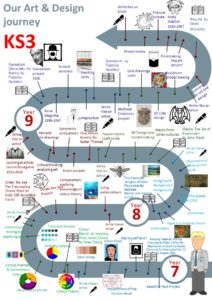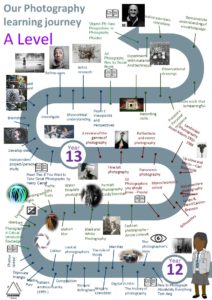Key Stage 3:
At St. Joseph’s, we believe that Art education should be a varied and exciting subject that cultivates individual and original creative expression.
We hope to equip our students with the knowledge and transferable skills necessary for them to develop and explore their creativity, as well as enhance their technical ability.
The Art Department is composed of professionals who share a passion for teaching and hold the belief that, in a diverse and technologically advancing world, the arts serve as an expression of our culture’s deeper value.
Our vision for every fine arts student includes the belief that education in the arts encourages students to develop intelligence not exercised in other classes. Arts education values both the process and the product. The arts have a far-reaching potential to help students achieve educational goals outside the discipline.
Within art lessons we give students the opportunity to analyse the work of artists and crafts people and to understand the context of the exploration of materials and processes they are using to create their own artwork.
Students will explore a range of traditional and new media to create artwork and in the process develop confidence, competence, imagination and creativity.
They will learn to apply their understanding and think in the same way as artists, crafts people and designers to help give them a better understanding of the roles they play within the creative industries.
Why Should I Study Art at GCSE
Secondary national curriculum-Art and design

Key Stage 4:
Fine Art
When Studying GCSE Fine Art at St Joseph’s we build on the skills, knowledge and experience gained in KS3. We offer students the opportunity to meet the AQA Assessment Objectives when studying projects based around Portraiture, Still Life and a Personal Inquiry. Students are also required to carry out an Externally Set Project which includes a 10 hour exam. The practical nature of GCSE Fine Art demands a high level of commitment from students to ensure that they meet the standard required from them for both coursework and exam components.
Component 1: Portfolio
What’s assessed:
A portfolio that in total shows explicit coverage of the four assessment objectives. It must include a sustained project evidencing the journey from initial engagement to the realisation of intentions and a selection of further work undertaken during the student’s course of study.
How it’s assessed:
- 96 marks
- 60% of GCSE
Non-exam assessment (NEA) set and marked by the school and moderated by AQA
during a visit. Moderation will normally take place in June when the student is in year 11.
Component 2: Externally set assignment
What’s assessed:
Students respond to their chosen starting point from an externally set assignment paper relating to their subject title, evidencing coverage of all four assessment objectives.
How it’s assessed
- Preparatory period followed by 10 hours of supervised time
- 96 marks
- 40% of GCSE
Non-exam assessment (NEA) set by AQA; marked by the school and moderated by AQA during a visit. Moderation will normally take place in June.
Progression Model for Art GCSE Keystage 4

Key Stage 5:
Key stage 5 Art and Design Fine Art Studying Fine Art at advanced level is designed to encourage an adventurous and enquiring approach to the subject.
The main thrust of the programme focuses on developing and extending personal, creative, intellectual and practical skills and powers of communication in a visual form.
St. Joseph’s Art Department is a successful centre for the development of the visual arts which provides students with opportunities to learn to produce work of real quality.
Our teachers are committed, inspirational, demanding and fun and students are given individual attention and appropriate levels of support and guidance to enable them to produce high quality outcomes. Our scheme of study is a blend of practical projects and relevant theory so that students can explore various art forms.
Course Content
Personal Portfolio:
You will need to gather resource material for a project based on a personal issue or negotiated theme. You must develop a creative response to the personal research you have carried out in sketchbooks. For this unit you will be expected to explore a wide range of media, processes, techniques and technologies.
You are expected to continue to develop your knowledge, skills and understanding, whilst developing your own art work. In this project you must produce a portfolio of work, based on your observations, further research and the development of your ideas. In addition, you are required to produce a related well-illustrated personal study of approximately 1,000 – 3,000 words.
This should be a detailed study based on a particular issue or theme in which you have become interested during the course. It is expected that you will approach this study in a more focused and analytical way.
Controlled Assignment:
The Controlled Test consists of a range of questions set by the examination board to be used to a successful conclusion.
Higher Education/Career Prospects
This course can lead on to a wide range of higher education courses including: Fine Art, Graphic Design, Illustration, Textiles, Fashion Design, Architecture, Theatre and Costume Design, 3D Design, Sculpture, Ceramics, Jewellery Design, Interior Design, Photography, Film and Animation, History of Art, Design and Film.
There are a range of career opportunities including, art and design, crafts, fashion, film industry, museum and gallery work, photography, printing, publishing, teaching, television and radio and theatre.
Summer Bridging Project Photography





